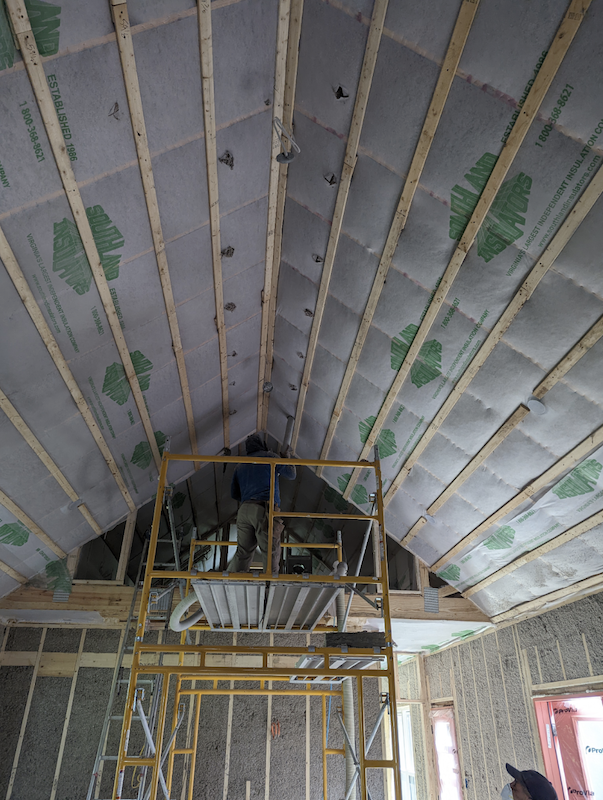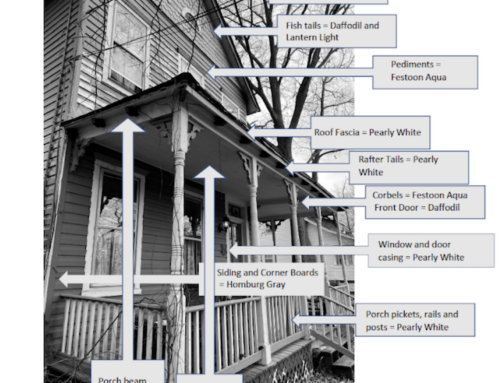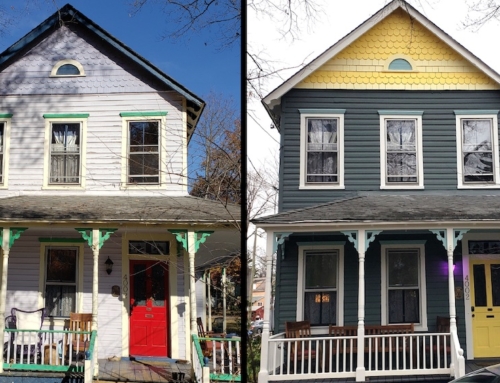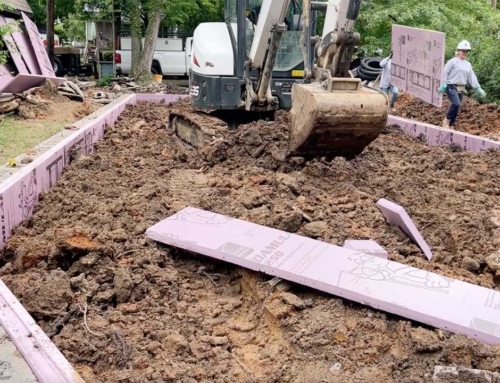Proper attic airflow is an important aspect to comfortable, healthy indoor living, but also to a roof’s structural integrity. Roof ventilation allows for the escape of hot air, minimizing moisture that can damage a roof’s strength and create mold.
But like many other construction changes resulting from building science research, there remains a divide on the necessity of more complicated, product-heavy assemblies.
Where lab results and data show a “correct” way to construct or remodel a home, arguments from the jobsite over cost, attainability, climate zone, and general necessity arise.
The discussion of whether or not to vent a roof recently popped up in a recent update of Pro Remodeler’s Model ReModel 2022 project.
The Model ReModel contractors, Nicole Tysvaer and Matt Kulp of Symbi Homes, debated two options for their vaulted ceiling: R-48 open cell spray foam at underside of roof with no soffit or ridge venting, or dense-packed cellulose with a vented soffit, baffles, and open ridge vent.
The conversation sparked great reader interest, and the reply of a well known building science expert, Michael Anschel of OA Design + Build + Architecture in Minneapolis.
While Anschel stands firm on studies and data determining the best roof assemblies, Symbi Homes argues that “best” may be difficult on affordability. In an attempt to strike a middle ground between high-performance and attainable, the three remodelers engaged in a candid conversation.
WHAT DOES SCIENCE SAY?
Anschel: There are techniques and systems that we hold on to that we continue to find ways to make them work, but we also have really clear, good data from organizations like Berkeley Lab or Oak Ridge Lab that shows us what the best assemblies are and how to manage the assemblies best.
I joke that we spend hours debating fan size or cubic foot ventilation size requirements for dwelling units. We are arguing in the hundreds of decimal points while we’re building to the quarter to the eighth of an inch. And there’s some significant disparity between the practices of building in the field and what happens in the labs. What might seem like a discussion at the lab level isn’t meant to be a discussion at the field level.
If you’re doing vaulted roofs, the best assembly is always going to be insulation on the exterior of the roof deck. If you’re doing a vaulted roof and in a mixed climate, you definitely need to stay away from vapor open assemblies.
Roof assemblies where you have framing, roof deck, and then you have layers of polyiso, and then you have your membrane—that’s going to be your best performer. Then we move into residential assemblies where we don’t necessarily want to do 50 boards, and so we look for compromises.
Those compromises can be in the form of a 50/50 split where you bring 50% of that insulation to the top side of the roof deck and the other 50% up to the underside of the roof deck in the form of closed cell spray foam, so that they function as a single air sealed assembly. You don’t have any air pathways through it.
The next solution would be the entirety of the installation is inside the framing cavity. Again, closed cell spray foam in a vaulted assembly so that you’re airtight to the roof deck.
And if you’re going to put venting in place, you’re going to put the venting on the top side of the roof deck the same as we would in a wall assembly. For ventilated rainscreen, it’s the same thing.
Once you’ve got your weatherproofing down, then you’re going to add furring strips or use one of the mat type systems to nail down over so that if there’s airflow taking place, it’s taking place between the shingle and the web. Not anywhere else in the assembly.
The old school method of bringing air into a building as a method of managing moisture that might build up at the underside of the roof decking is kind of antiquated.
The challenge is if you don’t want to use closed cell spray foams, right? Then you get into this question of, “Well, what are my alternative materials?”
And the problems with unvented attic assemblies with batt fiberglass is that they don’t work very well. You end up having to cut venting cavities, which doesn’t work for net zero or air tightness.
Low-density, low-medium density spray foams can be used in those assemblies, but require a vapor retarder that sprays over the surface over the foams to make them vapor impermeable.
BUT WHAT ABOUT COST? AND A PRODUCTS’ EFFECT ON THE ENVIRONMENT?
Symbi: Budget is a major factor. The perfect assemblies you talk about are very expensive. What I’m curious about is other assemblies that are more cost-effective for somebody with a budget? We want to remodel houses in neighborhoods that aren’t affluent and try to bring sustainability and lower people’s utility bills. Maybe the conversation is when to vent or when not to?
Anschel: The conversation is about how do we do high-performance affordable housing? Our spray foam vendors use zero GWP (global warming potentials) formula spray foam now. The carbon question is falling by the wayside.
Symbi: What about the GWP for Polyiso?
Anschel: There’s a trade off on everything. DuPont has a reformulated XPS formula with low GWP, but I wouldn’t use foam board in either assembly. Polyiso has a little bit higher R value per inch, yet it’s not zero GWP, but it’s not bad.
I think it’s really important to consider, in all of these things, is that we like to focus on foam. We really like to hone in on what’s the GWP of a board foot of foam. We don’t look at our urethane sealants, subfloor adhesives, or any other product category that way. It does the most for us in terms of air sealing, thermal comfort, that is done cleanly and easily. Because batt insulation or fluffy insulation, while it can be installed properly, is rarely installed properly.
BUT HUMIDITY IS BECOMING MORE INTENSE AND STANDARD SYSTEMS AREN’T EQUIPPED TO HANDLE IT.
Symbi: The other thing we found with spray foam too after using it for more than 10 years, is it’s so airtight that we get these really sticky areas. HVAC guys complain because they go into attic after attic where they’ve sprayed the underside of the roof and it’s damp.
Anschel: You hit on a really important point. When you foam the lid, that attic is part of the conditioned space. You have to be providing a supplier to that space. You have to condition the space as if it were part of the rest of the volume of space.
An HVAC installer should know that when they go into the project, that they have to be providing a supplier and return air in and out of that space and you have to be providing dehumidification for a home when you make a home tight.
Dehumidification is the name of the game. If you’re not doing dehumidification, the moisture is accumulating the space. The worst thing we could do would be to let that moisture travel through the insulation into the deck of the roof right where it slowly pulls that apart.
At our recent Building Science Bootcamp, there was a discussion on Energy Star’s certification program. The ER ratings on our AC systems don’t take into account the amount of energy necessary for proper dehumidification. So they’re promoting energy efficient equipment that is unable to perform the task.
Symbi: Yeah, and we just find that because it’s getting so humid here every year that the HVAC just can’t keep up. That’s another thing that adds cost to and adds another layer of complexity.
WE HAVE A METAL ROOF AND WANT NATURAL PLYWOOD ON THE CEILING.
Symbi: In terms of GWP, our insulation from Greenfiber blows everybody out of the water. Of course, that dense pack in the ceiling still gets really heavy. And so then we had the issue of how do we hold it up there with our framing 24 inches on center? Matt came up with this idea that we’re going to do plywood ceilings and just leave it exposed plywood. And we have a metal roof.
Anschel: The metal roof changes the equation because the metal roof gets really hot—350 degrees at the roof deck. Which is good because it pushes so it forces that vapor to evaporate out of the building material. The OSB or the plywood deck gets cooked by that metal roof, which is great for the building material.
The challenge becomes how do you air seal the plywood below it? You can do airtight assemblies with gasketing caulk and drywall gasket with acoustic sealant. I have a friend in the Carolinas they did a channel system. Same thing they wanted to do fluffy and so they had the roof deck furring strips and then they installed another layer of OSB air sealed that then put in their fluffy then put up their drywall.
If you go back and you look at the cost of additional materials and additional labor for the install. How different is that cost from what it would be to do that same assembly in a closed cell spray foam?
Visit the original post about this topic from July 2022. To Vent or Not to Vent
###
Thanks to our partners with ProRemodeler Magazine’s 2022 Model Remodel.








